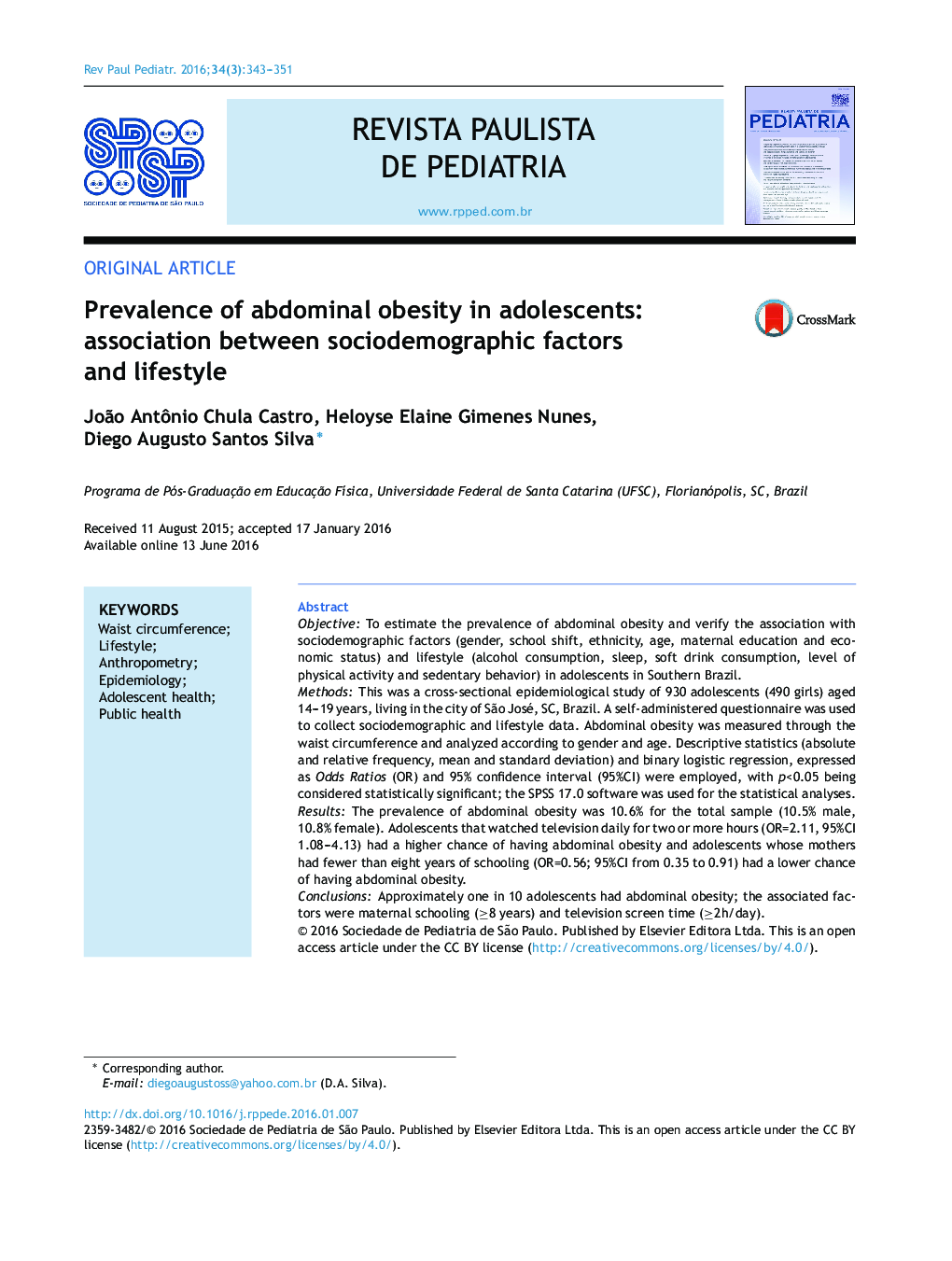| کد مقاله | کد نشریه | سال انتشار | مقاله انگلیسی | نسخه تمام متن |
|---|---|---|---|---|
| 4176114 | 1607961 | 2016 | 9 صفحه PDF | دانلود رایگان |
ObjectiveTo estimate the prevalence of abdominal obesity and verify the association with sociodemographic factors (gender, school shift, ethnicity, age, maternal education and economic status) and lifestyle (alcohol consumption, sleep, soft drink consumption, level of physical activity and sedentary behavior) in adolescents in Southern Brazil.MethodsThis was a cross-sectional epidemiological study of 930 adolescents (490 girls) aged 14–19 years, living in the city of São José, SC, Brazil. A self-administered questionnaire was used to collect sociodemographic and lifestyle data. Abdominal obesity was measured through the waist circumference and analyzed according to gender and age. Descriptive statistics (absolute and relative frequency, mean and standard deviation) and binary logistic regression, expressed as Odds Ratios (OR) and 95% confidence interval (95%CI) were employed, with p<0.05 being considered statistically significant; the SPSS 17.0 software was used for the statistical analyses.ResultsThe prevalence of abdominal obesity was 10.6% for the total sample (10.5% male, 10.8% female). Adolescents that watched television daily for two or more hours (OR=2.11, 95%CI 1.08–4.13) had a higher chance of having abdominal obesity and adolescents whose mothers had fewer than eight years of schooling (OR=0.56; 95%CI from 0.35 to 0.91) had a lower chance of having abdominal obesity.ConclusionsApproximately one in 10 adolescents had abdominal obesity; the associated factors were maternal schooling (≥8 years) and television screen time (≥2h/day).
ResumoObjetivoEstimar a prevalência de obesidade abdominal e verificar a associação com fatores sociodemográficos (sexo, turno de estudo, cor da pele, idade, escolaridade materna e nível econômico) e o estilo de vida (consumo de álcool, sono, consumo de refrigerante, nível de atividade física e comportamento sedentário) em adolescentes do Sul do Brasil.MétodosEstudo epidemiológico descritivo transversal, feito com 930 adolescentes (490 do sexo feminino) de 14–19 anos de São José, SC, Brasil. Usou-se questionário autoadministrado para coletar dados sociodemográficos e do estilo de vida. A obesidade abdominal foi avaliada pelo perímetro da cintura e analisada de acordo com sexo e idade. Empregou-se estatística descritiva (frequência absoluta e relativa, média e desvio padrão) e regressão logística binária, expressa em Odds Ratio (OR) e intervalo de confiança de 95% (IC95%), foi significativo p<0,05 e usou-se o software SPSS 17.0.ResultadosA prevalência de obesidade abdominal foi de 10,6% para mostra total (10,5% masculino; 10,8% feminino). Adolescentes que assistiam à televisão diariamente por duas ou mais horas (OR=2,11; IC95% 1,08–4,13) apresentaram maiores chances de obesidade abdominal e os adolescentes cujas mães tinham escolaridade inferior a oito anos (OR=0,56; IC95% 0,35–0,91) tiveram menor chance de obesidade abdominal.ConclusõesAproximadamente um a cada 10 adolescentes apresentou obesidade abdominal, os fatores associados foram a escolaridade materna (≥8 anos) e o tempo de tela de televisão (≥2 horas/dia).
Journal: Revista Paulista de Pediatria (English Edition) - Volume 34, Issue 3, September 2016, Pages 343–351
